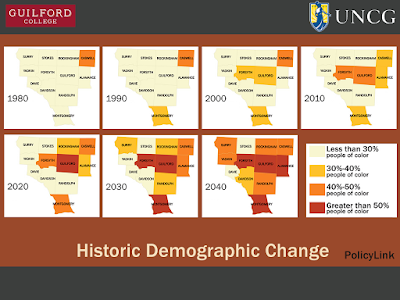“Engaging the New Diversity: Connecting Service Learning/Community Engagement (SLCE) to Research”
Campus Compact Summer Network Meeting, Aug 1, 2017
Pfeiffer University, Misenheimer NC
Highly collaborative CBR and CBPR examples
Campus Compact Summer Network Meeting, Aug 1, 2017
Pfeiffer University, Misenheimer NC
Highly collaborative CBR and CBPR examples
What’s the problem?
In higher ed we haven't designed the form with all the boxes students need to check in order to capture and define who makes up the New Diversity. This is not news. Demographers have predicted these shifts for decades.
The New Diversity students are refugee, immigrant, first-generation, Latinx, newcomer, minority. They are LGBTQ, people of color, documented and undocumented. They represent the kind of change most major metropolitan regions in the US have already experienced but which is new to the South.
The New Diversity students are refugee, immigrant, first-generation, Latinx, newcomer, minority. They are LGBTQ, people of color, documented and undocumented. They represent the kind of change most major metropolitan regions in the US have already experienced but which is new to the South.
Greensboro is an example of a medium-sized, historically white and black Southern city now experiencing unprecedented population diversity. From Mobilizing and Mentoring the "Next Generation" Through CBPR : The Montagnard Refugee Household Hypertension Project, 2016 Society for Applied Anthropology conference
Twelve-county economic region. Greensboro is located in Guilford County, historically the state of North Carolina's number one refugee resettlement area. From Mobilizing and Mentoring the "Next Generation" Through CBPR : The Montagnard Refugee Household Hypertension Project, 2016 Society for Applied Anthropology conference
The South and the Nation. From Mobilizing and Mentoring the "Next Generation" Through CBPR : The Montagnard Refugee Household Hypertension Project, 2016 Society for Applied Anthropology conference
Why care?
Change is happening faster than institutions are willing to admit. Time is not on our side. Experts predict that many small liberal arts colleges will fail in the post-Great Recession period. Some think rising costs will finally force them to close. Perhaps more likely will be their failure to respond to the New Diversity.
Why is our solution better than others?
We use existing structures and tools of academia. We don't invent a new language of acronyms and buzz words. We recognize and welcome the New Diversity in community and classroom. Learners and their experiences, skills, traditions, languages, cultures and perspectives are recognized and validated through Service Learning, Community Engaged Scholarship and Community-Based Participatory Research (CBPR). As part of Service Learning training, we directly address issues like social justice, anti-racism and cultural competency as learnable skills mastered through practice. Learners operate as community members, language and cultural insiders and co-educators, and are equitably rewarded (scholarship, grant, credits, internship, co-authorship, etc.)
Pyramid Model: Relationship of Service Learning to CBPR. From Mobilizing and Mentoring the "Next Generation" Through CBPR : The Montagnard Refugee Household Hypertension Project, 2016 Society for Applied Anthropology conference
Timeline Model: Aligning campus and community timelines. From Mobilizing and Mentoring the "Next Generation" Through CBPR : The Montagnard Refugee Household Hypertension Project, 2016 Society for Applied Anthropology conference
Iceberg Model: Comparing scales of the individual, monoculture mindset to the monocultural institution.
Do we have the team and expertise to carry it out?
Yes. We have built teams of like-minded, committed educators, researchers, community leaders and youth allies. For example, the Montagnard Refugee Household Hypertension Project has included half a dozen academics from several Triad colleges and universities, Montagnard doctors and health professionals, community health workers, political and religious leaders, women, and youth. It has involved more than 100 college and university students with Montagnard youth leading the way as interpreters, translators and cultural experts. The project has been on-going since 2011.
What a socially just, anti-racist and culturally competent team of students looks like. From Mobilizing and Mentoring the "Next Generation" Through CBPR : The Montagnard Refugee Household Hypertension Project, 2016 Society for Applied Anthropology conference







